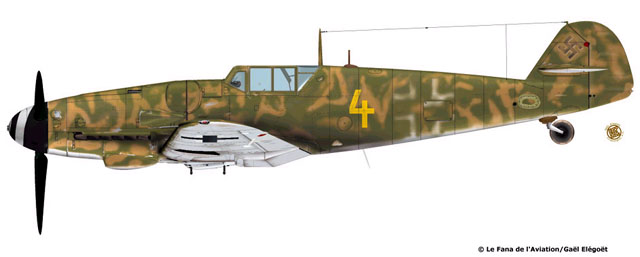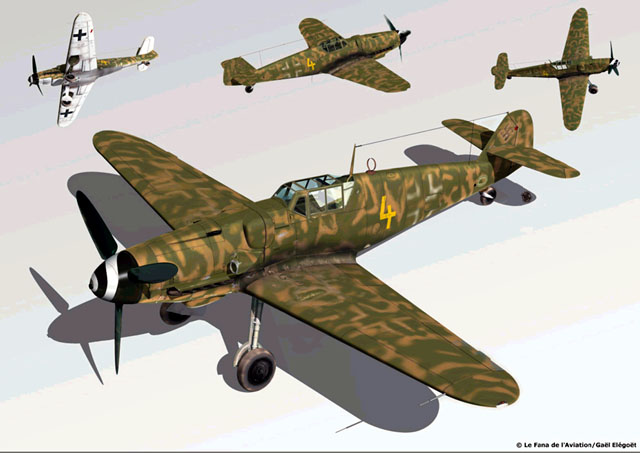
|
Messerschmitt Bf 109G-6 W.Nr. 160756 |
By GaŽl ElegoŽt, Dec 2000

The complete story of the NASM Bf109G-6 (W.Nr 160756) was published in the "Fana" magazine some months ago. That plane was flown to an American airfield in Italy in 1944 by is pilot, Renť Darbois, a French Alsacian who joined the Luftwaffe to learn flying with the objective of escaping occupied France. After instruction at JG 103 in France and EJG 1 in Germany, he joined the I./JG4 at Maniago, Italy, and deserted during a ferry mission on the 25th July 1944.
He landed at Santa Maria Capua Verde airfield, north of Napoli.

Colors and Markings of 160756
The author of the article, Jean-Michel Goya, found some pictures of the bird just after his landing and I was asked to reproduce it in 3d as accurately as possible to display the colors and markings. These are very different from the colors in which the plane was restored. Here is a brief description:
W.Nr 160756 certainly came out of the factory painted in the classic Luftwaffe camouflage for the European theatre of operation - RLM74 and RLM75 greys on the upper surfaces, and RLM76 light blue-grey on the under surfaces and fuselage sides, with grey and RLM70 Black-green and RLM02 Grey-green patches also on the sides.
In the field, the aircraft received a crudely painted green and tan camouflage. It is not clear in what order theses paints where applied, green atop the tan, leaving some tan patches, or green first then some tan patches. Much of the national markings on the upper wings surfaces, the fuselage and fin were partially oversprayed with these colours. The under surfaces markings remaining unchanged.

No service stencils have survived the application of the camouflage paint. Even the manufacture plate on the port fuselage side near the cockpit was painted over.
In contrast, the yellow number 4 is very clear and regular, so it was certainly painted after the camouflage paint. The spinner is described by the American services report like been black (but the RLM70 black-green was often taken for black) with a large white spiral.

Although this plane was based in Italy, it did not received the usual white theatre markings (wings tips and fuselage band) for the Mediterranean theatre of operation.
Note the repainted area on the port side near the tail wheel, on a well contour. There are other very dark paint patches on the port rudder axis and on the under surfaces of the port aileron. These patches are most likely a dark primer red, colour of the fabric covering varnish.
The exact shades of the green and tan paints are unknown. The American report describes them only as "green and tan" without any more precision and the pictures are in black and white, so there is no way to know more. Jean-Michel Goya (author of the article in the "Fana de l'Aviation" think it may be some Italian shades, dark green "Verde scuro" or "bottle" green "Verde bottiglia" and some brown "Ocra" or tan "Sabbia". It is very possible, as the aircraft was based in Italy in 1944.
There are some other German planes based in Italy at the same time known to have been camouflaged with green/tan paints applied on the field atop the usual factory grey or green camouflage, namely the Focke-Wulf Fw-190 F-8's of SG 4 and SKG 10 or even some other Bf-109G-6, like "red 16" of 8/JG 53 at Managio in June 1944 or "yellow 8" of 3/JG 4 also at Managio in July1944. This last one looks like a twin of our "Yellow 4". The only differences are a white fuselage band partly masked by the camouflage and the lack of spiral on the spinner.

Some references describe the green/tan paints as OlivgrŁn RLM80 (olive-green) and Sandgelb RLM79 (yellow-tan). Perhaps the Germans used Italian paints and labeled it with German designations. Judging the differences between those German green/tan paints and the Italian tones is very difficult. The shades vary with the kind of light (time of the day, the weather) or with the type of film in use.
As the aircraft was reproduced in 3D, we find the same variations of shades depending the type of lights and settings used for the renderings.
To see 160756 as she is today, click here to visit the Walkaround in the Photo Reference section.